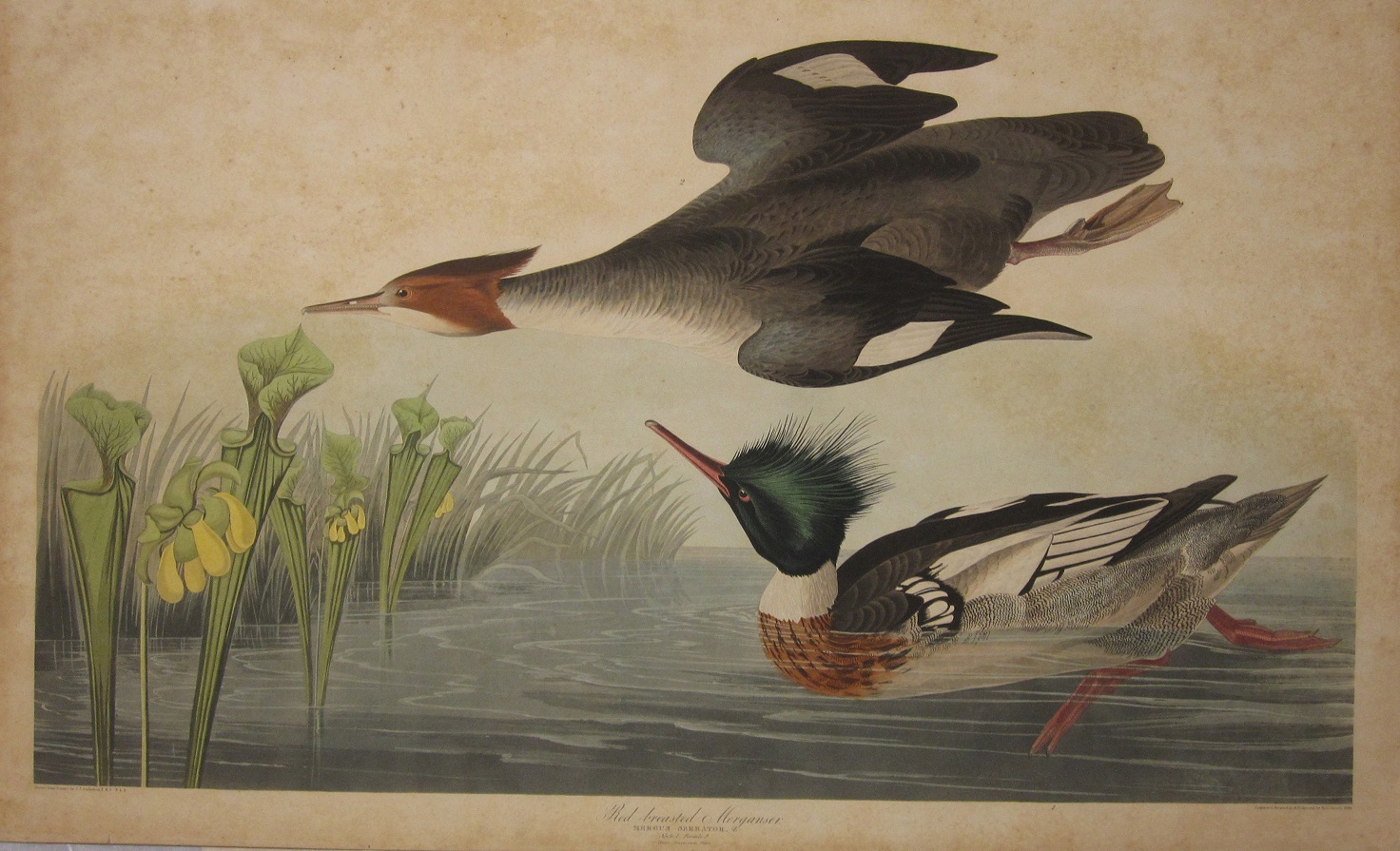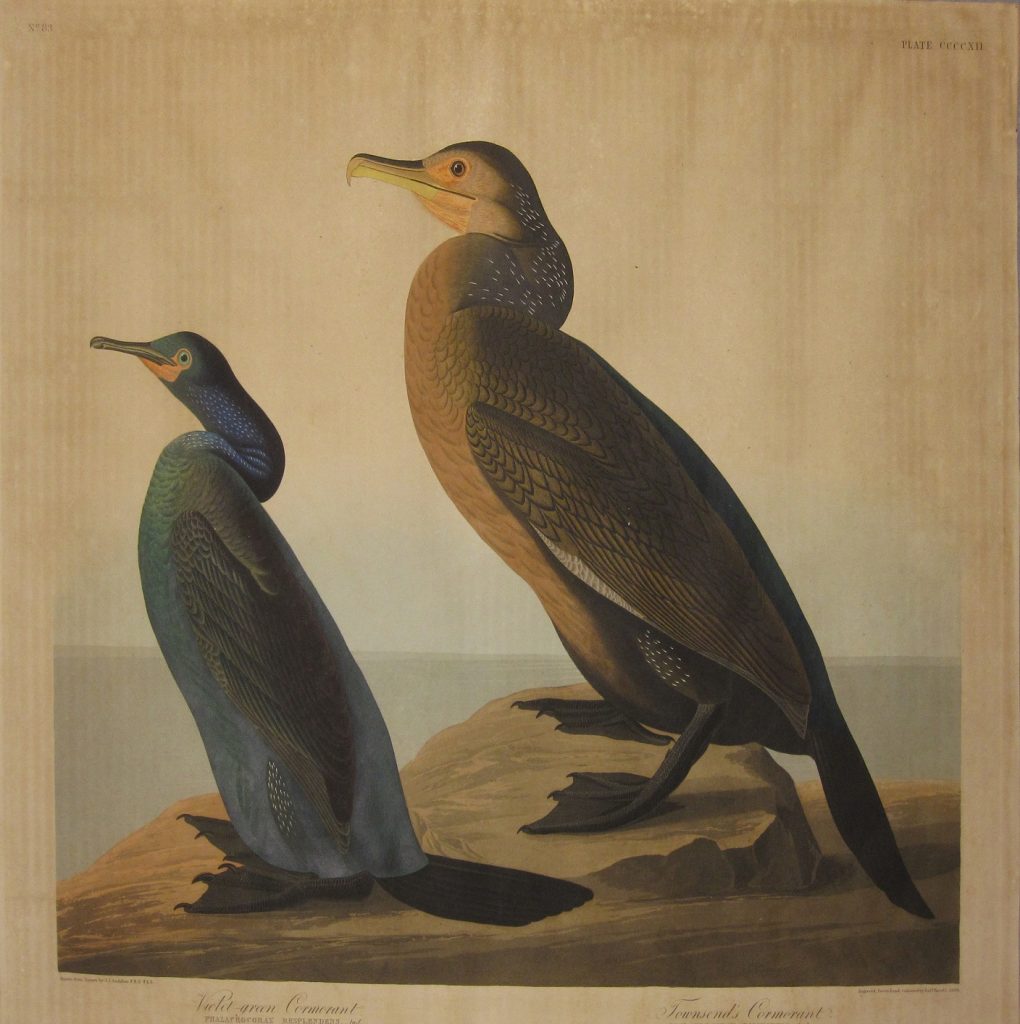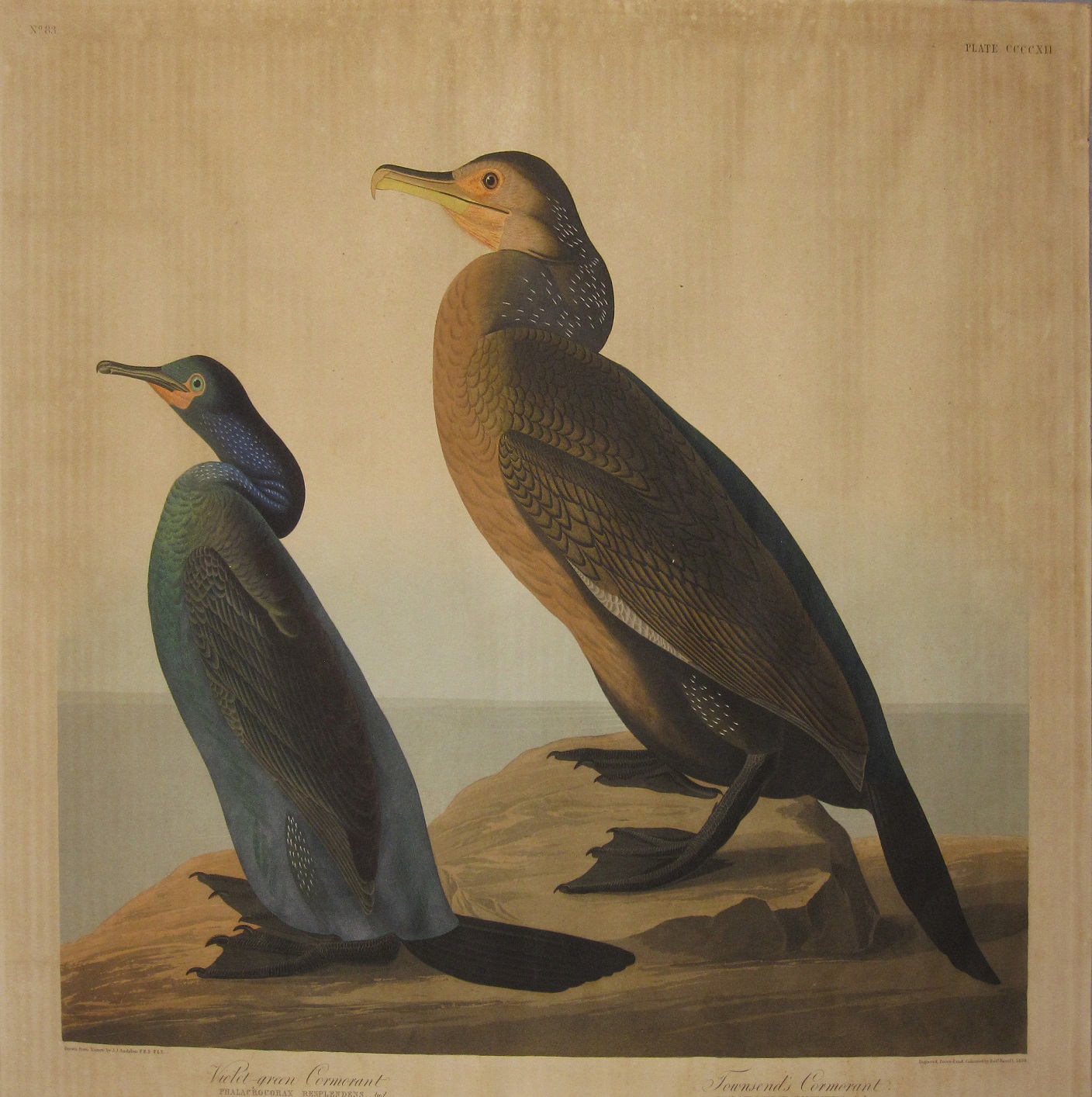I am fortunate to live in a house with big, floor-to-ceiling windows. While researching the CFAM collection I often sit by one of these windows, and occasionally steal a glance outside. When I do, I nearly always see some bird or another, in more variety than anywhere else I have lived. I have never been much of a bird watcher, but this spring I have found myself enthusiastically looking up the birds I see, using Google searches to figure out the ones I don’t recognize. A partial list of my sightings includes blue jays, bluebirds, robins, crows, grackles, goldfinches, cardinals, turkey vultures, a red-tailed hawk, and, one day, an absolutely gorgeous pileated woodpecker. You can perhaps imagine my delight, then, to discover that CFAM owns two prints from the famed Birds of America by John James Audubon, though I am unlikely to find either of them outside my window here in the Blue Ridge.

After: John James Audubon (American, 1785–1851)
Red-Breasted Mergansers, 1838, Engraving, etching, and aquatint, 25 ¼ x 38 ¼ in.
Bequest of Virginia S. Nelson, 1992.16.14
Both of the prints, which came to the museum as part of the bequest of collector Virginia S. Nelson, depict water birds. The first, Red-Breasted Mergansers, depicts a duck that breeds in Northern Canada during the summers before traveling southward during the winter. They nest around lakes, but tend to overwinter in coastal bays, which means you may catch sight of them in Tampa Bay or other Florida estuaries during the winter months.1 The other, Violet-Green Cormorant, depicts a bird we now know as the pelagic cormorant, the smallest of the West Coast cormorants, with a range that is unlikely to bring it anywhere near coastal Florida, much less mountainous Virginia.2

After: John James Audubon (American, 1785–1851)
Violet-Green Cormorant, 1838, Engraving, etching, and aquatint
25 ¼ x 28 ¼ in., Bequest of Virginia S. Nelson, 1992.16.15
Though it is perhaps disappointing that the museum does not own one of Audubon’s depictions of one of Florida’s many birds, perhaps the wonderfully contorted American flamingo, these two prints provide an opportunity to discuss some of Audubon’s working methods. Basically, Audubon spent nearly a decade traveling throughout North America, from Labrador in Northern Canada to the Florida Keys, and at least as far west as Louisiana. While in the field he made watercolor drawings of the birds he encountered, all while taking prodigious notes on what he saw. He then transported his drawings to London, where the master printmaker Robert Havell translated them into the form familiar to us today. Audubon was committed to representing every bird in life size, and so made the audacious decision to have the plates printed on a paper known as double-elephant folio, the largest then available. In order to finance the massive cost of the undertaking, Audubon sold the prints by subscription to libraries, universities, and wealthy collectors on both sides of the Atlantic. An accompanying Ornithological Biography included descriptions of the birds and their habits, as well as Audubon’s reflections on the cultural life of the American interior in the early twentieth century.3
Though we now know him as the namesake of the country’s primary bird conservation organization, Audubon came from a very different time. Like most of the Western artist-naturalists who ranged the world categorizing its diversity of plant and animal life, he was a prodigious hunter, and did not see any contradiction between killing animals and studying them scientifically—in fact, he saw the two as inextricably linked. The Ornithological Biography provides ample evidence of this. The text is liberally interspersed with his thoughts on the gustatory pleasures (and displeasures) of the birds he documented, as well as of other wildlife from the North American interior (he was a big fan of opossum). He also provides commentary on the tastes of bird eggs, which he often enjoyed much more than the birds themselves.4 Of red-breasted mergansers he reports, “The flesh of the bird is tough, and has a fishy taste.”5 He doesn’t report on the taste of the cormorant, likely because he never saw it in person.6 Though Audubon traveled widely, he lived in a time before transcontinental travel, and seems only to have gone as far west as the Mississippi.7 Instead, he relied on a skin sent to him by a Mr. Townsend, who had shot the bird at the mouth of the Columbia River, on Cape Disappointment.8 In fact, though Audubon prided himself on his lifelike representations of birds, they were never drawn from life. Rather, he shot and killed the birds, using a system of wires to rig them in his preferred pose against a grid background. Then, he worked feverishly to capture the bird before it began to rot.9 Audubon lived at a time when birds were extremely plentiful—in the Ornithological Biography he writes of a time when he was traveling in Kentucky and the multitude of passenger pigeons he saw literally blotted out the sun, as if there had been an eclipse.10 Towards the end of his life, however, he began to sense that something was changing, that men of European descent were overly rapacious, and were beginning to have a negative impact on the plenitude of birds in North America. Still, even as he lamented the poachers who were destroying Labrador’s population of puffins and other seabirds, he continued to shoot them and sample their eggs.11 It was not until the turn of the twentieth century that state Audubon Societies would start to crop up, turning this complicated nineteenth century hunter-artist-naturalist into one of today’s foremost symbols of conservation.12
1 “Read-breasted Merganser.” The National Audubon Society, Accessed May 20, 2020.
2 “Pelagic Cormorant.” The National Audubon Society, Accessed May 20, 2020.
3 For a general overview of the creation and publication of The Birds of America, see Audubon’s Elephant America’s Greatest Naturalist And The Making Of The Birds Of America. (Owl Books, 2005). Much of the Ornithological Biography is reproduced in John James Audubon et al., John James Audubon, Writings and Drawings (New York: The Library of America, 1999), and it is also in the public domain and available in various forms online, including from the Audubon Society, which reproduces the commentary on each bird along with the plates in its “Audubon’s Birds of America” pages.
4 Eilzabeth Gawthorpe Riely, “John James Audubon’s Tastes of America,” Gastronomica 11, no. 2 (2011): 29–31.
5 John James Audubon. “Red-Bresated Merganser.” National Audubon Society, Accessed May 20, 2020.
6 He did comment on the tastes of other marine birds, generally finding them revolting. See Christoph Irmscher, “Audubon Goes North,” in Cultural Circulation, ed. WALDEMAR ZACHARASIEWICZ and CHRISTOPH IRMSCHER, 1st ed., Dialogues between Canada and the American South (Austrian Academy of Sciences Press, 2013), 77–98.
7 Jennifer L Roberts, Transporting visions: the movement of images in early America, 2014, 81.
8 John James Audubon. “Violet-green Cormorant and Townsend’s Cormorant.” National Audubon Society, Accessed May 20, 2020.
9 “John James Audubon’s Tastes of America,” 40–41.
10 John James Audubon. “Passenger Pigeon.” National Audubon Society, Accessed May 20, 2020.
11Irmscher, “Audubon Goes North,” 84.
12 “Our History.” National Audubon Society, Accessed May 20, 2020.

